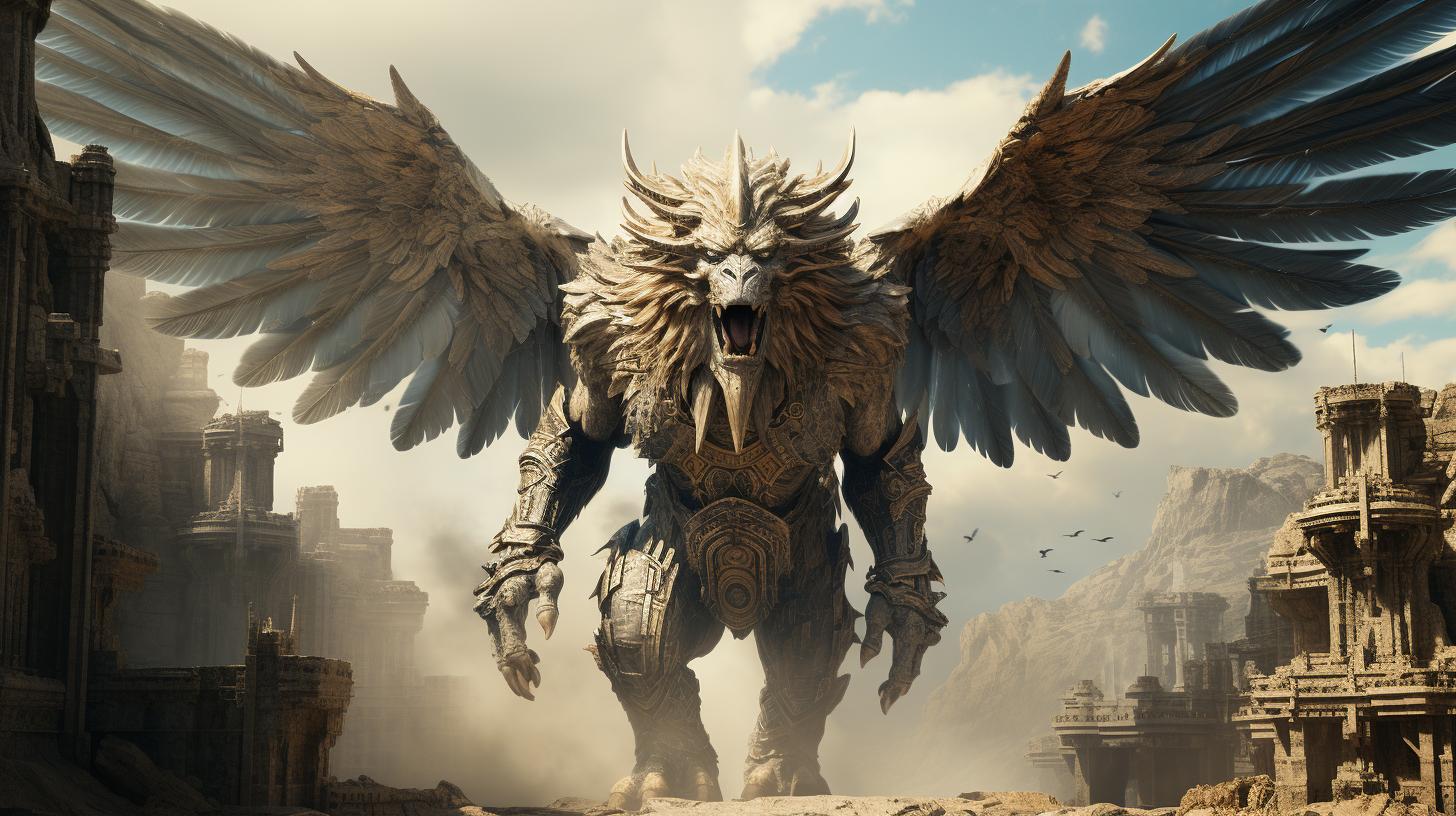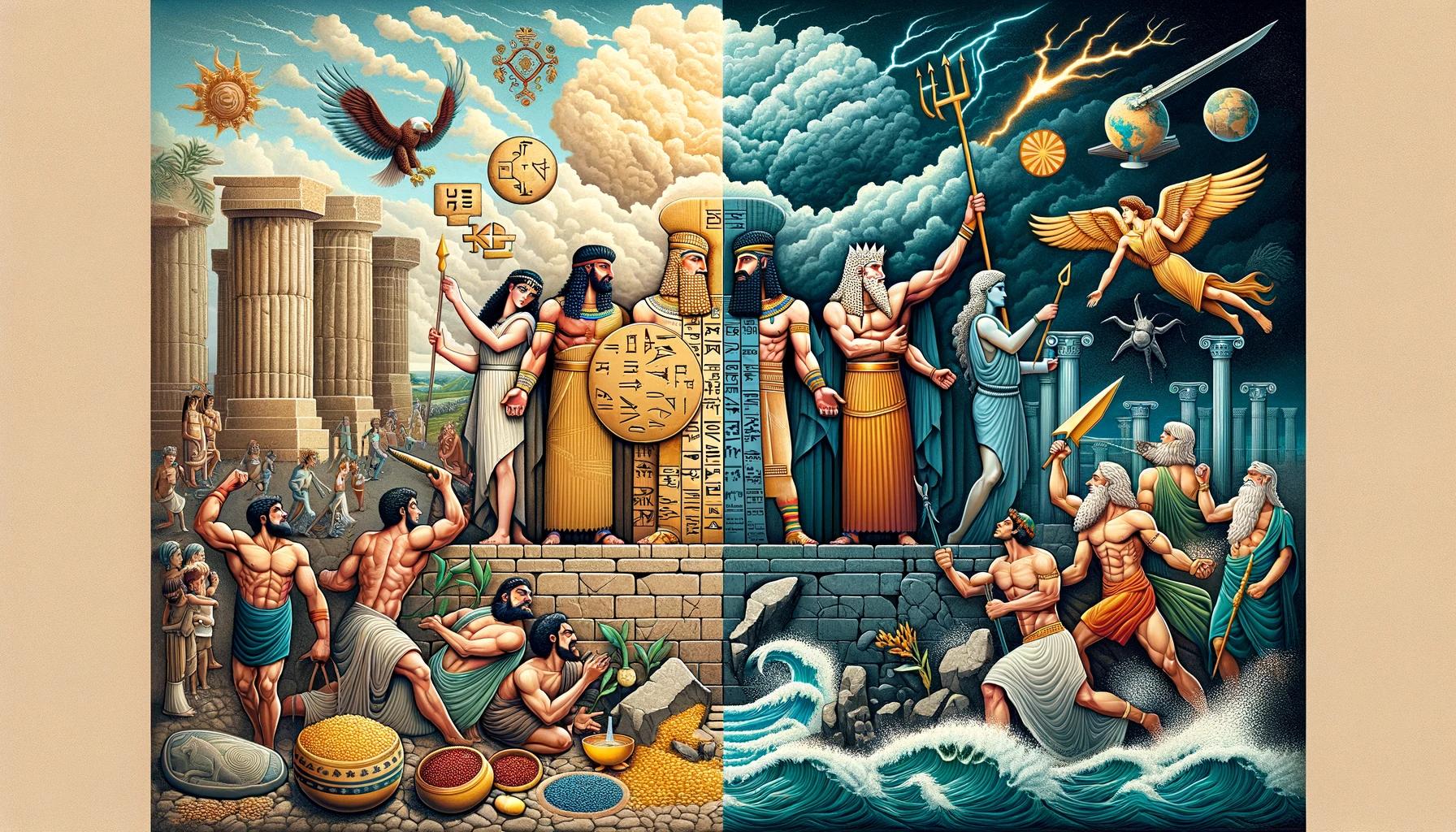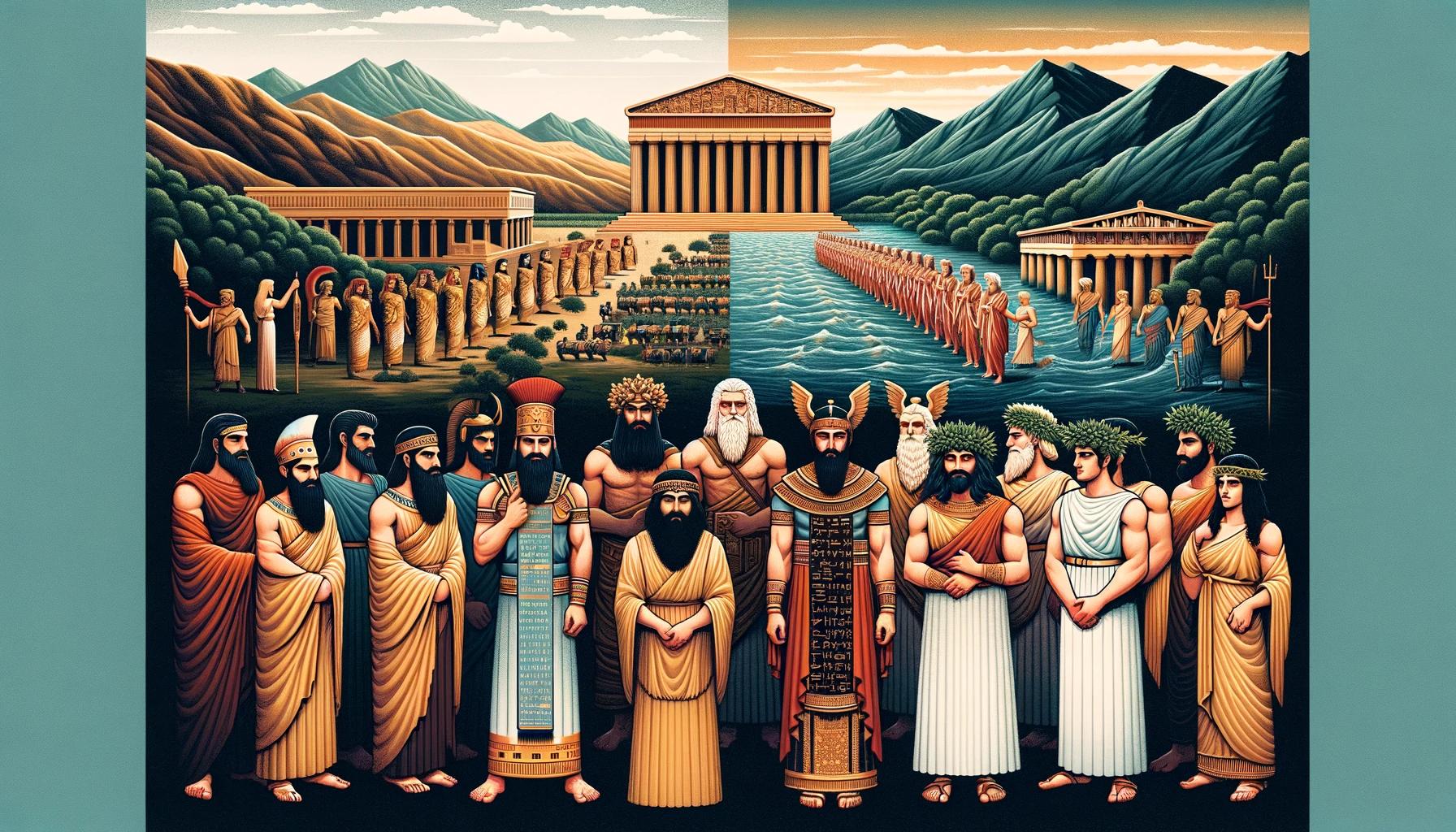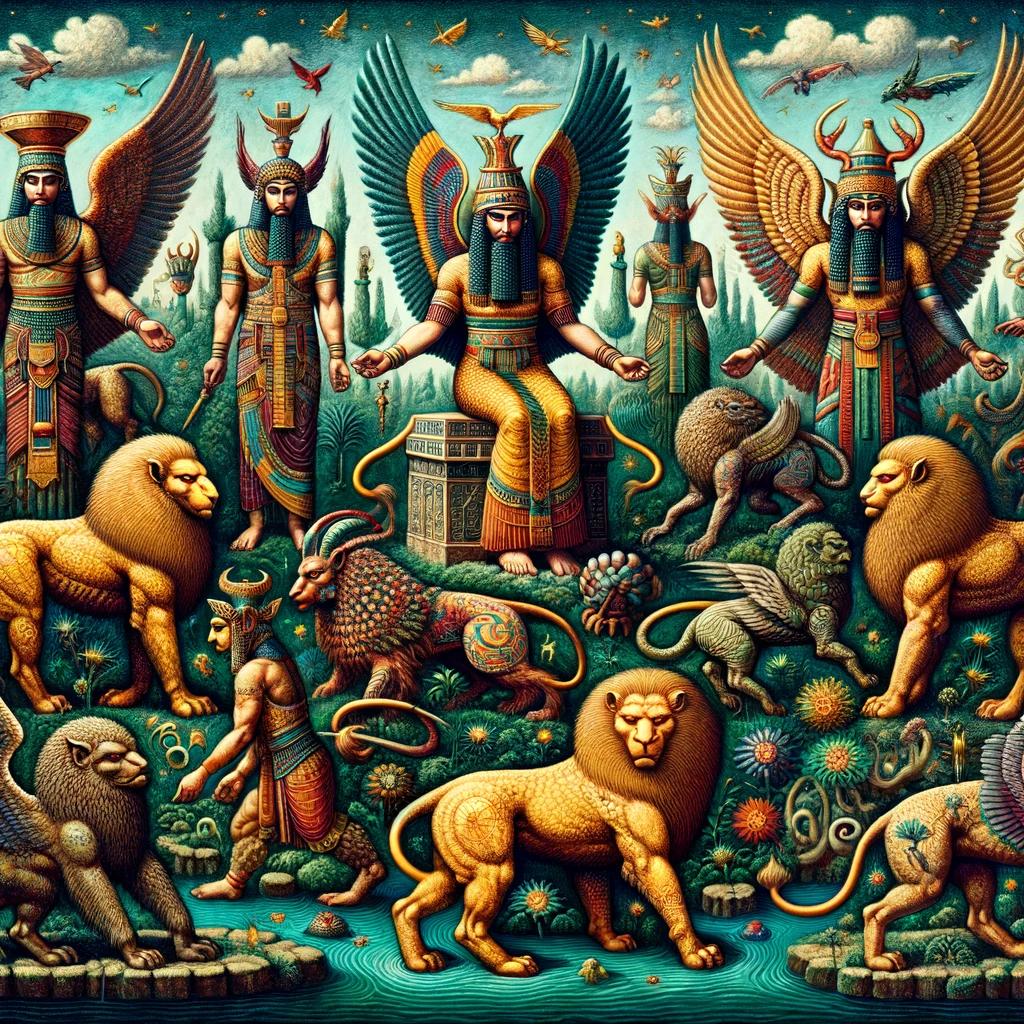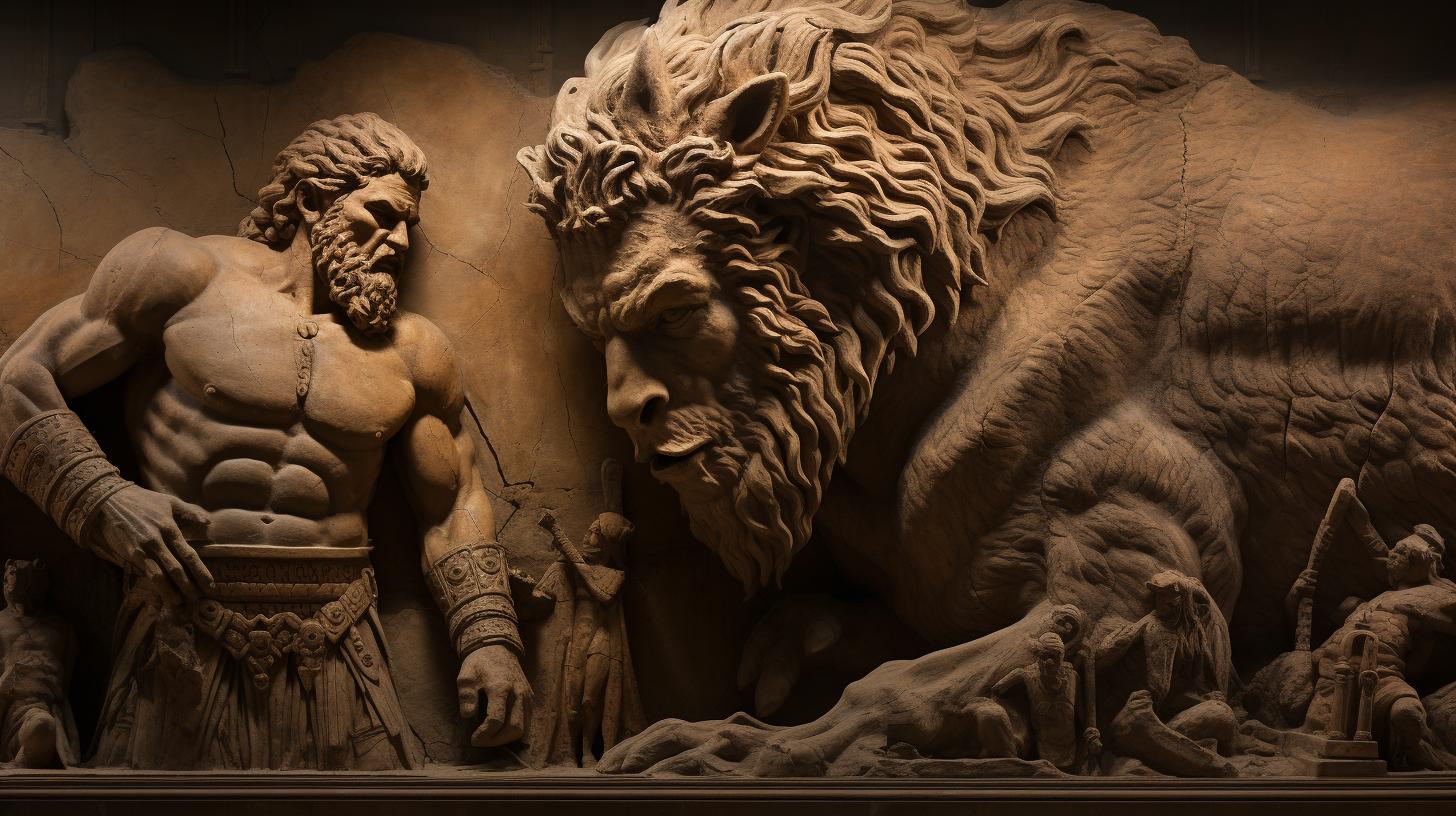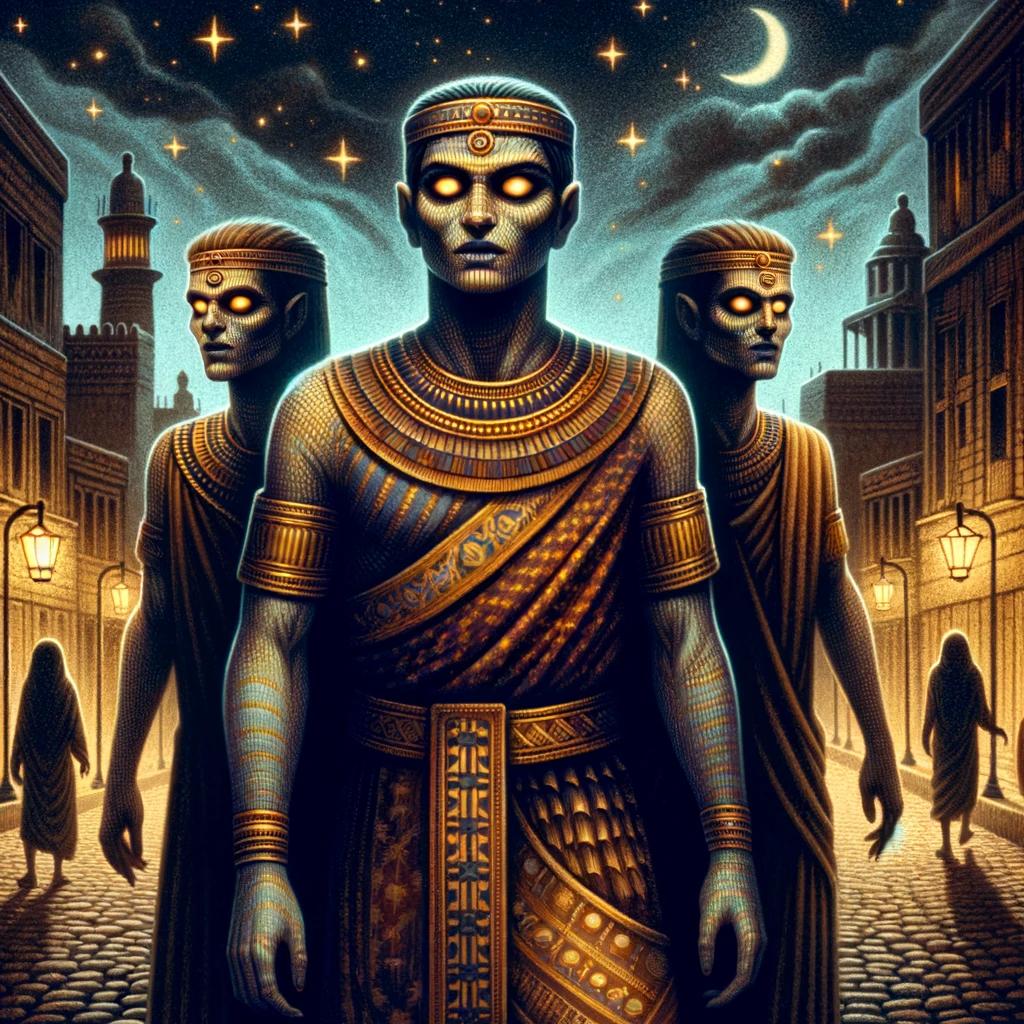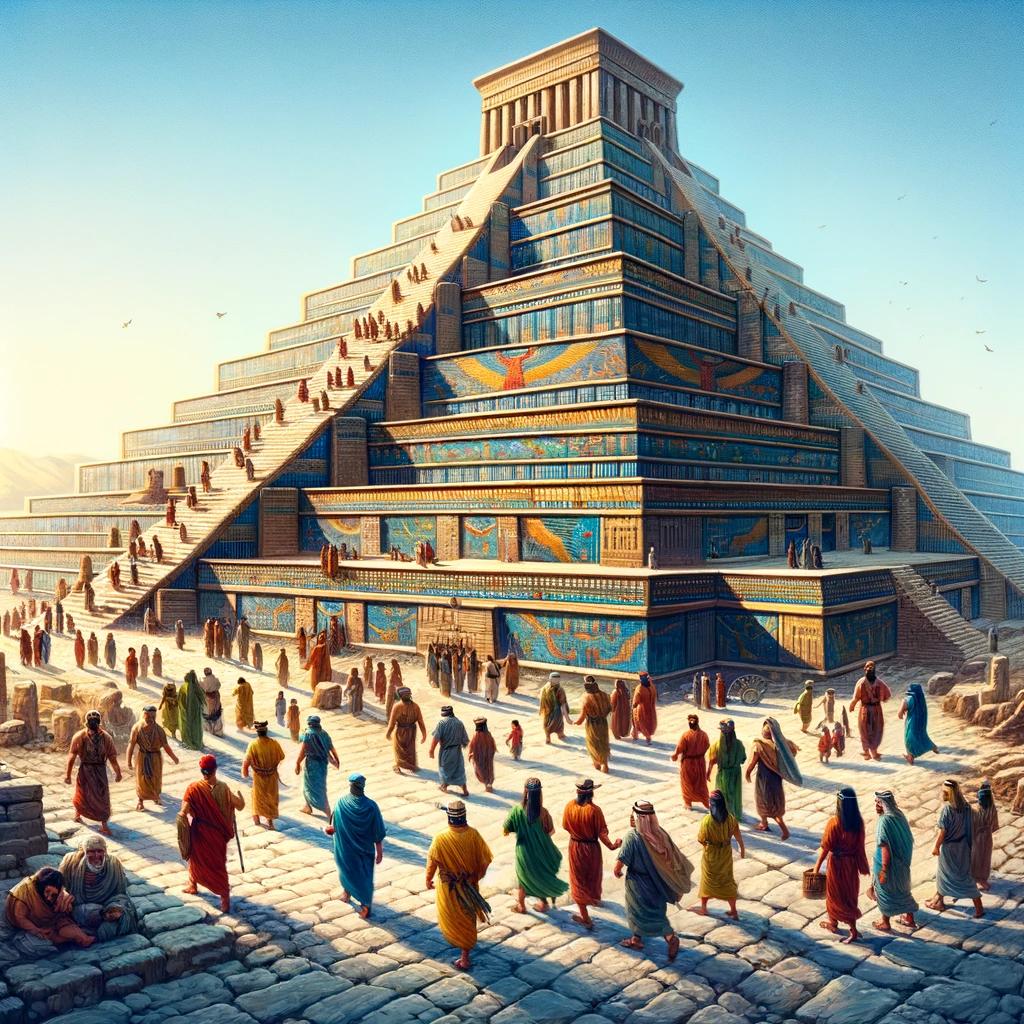Lamassu Mythology: A Fascinating Exploration of Ancient Assyrian Deities
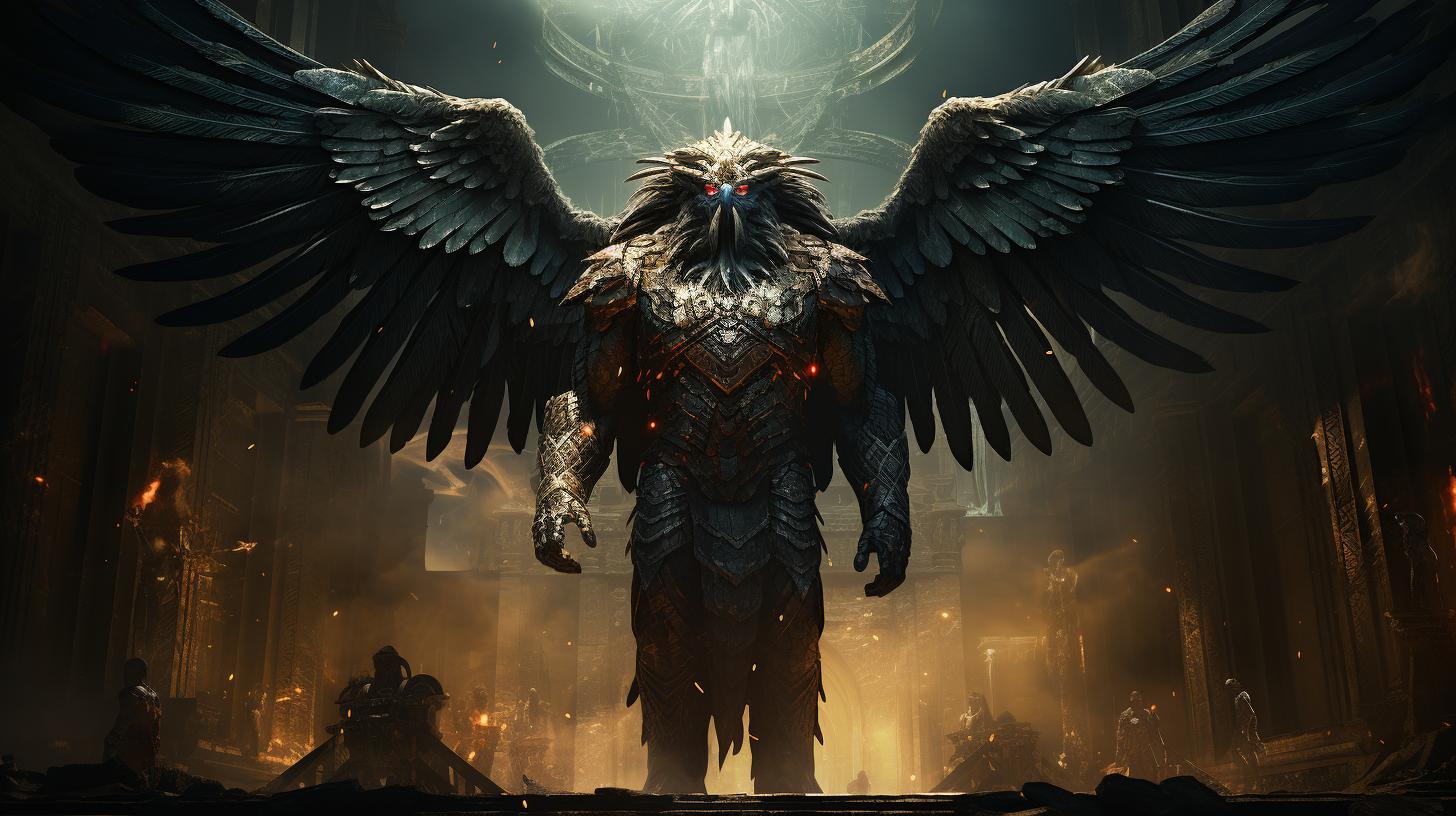
The article on Lamassu mythology provides a fascinating exploration of these ancient Assyrian deities. It delves into their origins in Sumerian mythology and the evolution of their iconography in Mesopotamia.
The male and female counterparts of Lamassu, known as Shedu, are also discussed. The article sheds light on the significance of Lamassu in ancient Assyrian culture and their role as protectors of cities and homes.
Additionally, it explores the presence of Lamassu in modern culture and art, as well as their association with the Hittite-Hurrian goddess Inara. The legacy of Lamassu can be seen in various museums and exhibitions worldwide, including the British Museum and the Metropolitan Museum of Art.
The Origins of Lamassu in Sumerian Mythology
In the fascinating realm of Sumerian mythology, the origins of Lamassu take us back to ancient Mesopotamia. These majestic and enigmatic beings were initially depicted as a goddess named Lamma during the Sumerian era.
However, as time passed, their representation morphed into a hybrid creature with the head of a human, the body of a bull or lion, and the wings of a bird.
Lamassu’s presence in Sumerian mythology and art symbolized their significance as protectors and guardians. The depiction of Lamassu as a deity showcases their association with the cosmos, zodiacs, and parental stars.
These celestial beings were not merely physical, as they embodied intelligence, strength, and freedom.
The motif of a winged animal with a human head, which includes Lamassu, has its roots tracing back to Ebla in 3000 BCE. The ancient depiction of Lamassu highlights their mythological and cultural significance in the region.
Over time, Lamassu evolved within the Assyrian and Akkadian culture, taking on various names such as Lamassu, Alad, and Shedu. Yet, their essence as symbols of protection and power remained unchanged, resonating throughout the ancient Assyrian cities.
Their significance extends beyond mythology, as Lamassu became a prominent element in the art and architectural landscape of Mesopotamia. Their colossal statues were often placed at the entrances of palaces, acting as awe-inspiring guardians.
The Lamassu statues served not only as visual representations of power but also as spiritual protectors against chaos and harm.
In summary, the origins of Lamassu in Sumerian mythology unveil their transformation from a goddess to a hybrid creature embodying celestial and protective qualities. Their evolution and symbolism manifested in the art, architecture, and cultural practices of ancient Assyria, leaving an enduring legacy that captivates us to this day.
Evolution of Lamassu Iconography in Mesopotamia
The evolution of Lamassu iconography in Mesopotamia showcases the transformation of these ancient Assyrian deities and their symbolic representations. As protective deities, Lamassu served as guardians and bringers of fortune. Their symbolism evolved over time, incorporating various elements from different cultures.
Lamassu as Protective Deities and their Symbolism
Lamassu were revered as powerful protectors in Mesopotamian culture. With their hybrid form of human-headed, winged beasts, they were believed to possess immense strength and divine intelligence. Lamassu were often depicted with a muscular lion or bull body, signifying their ability to ward off evil forces and safeguard homes and cities.
The symbolism of Lamassu represented the harmony between human and animal elements. The human head symbolized intelligence and wisdom, while the animal body embodied strength and ferocity. This duality showcased the ideal characteristics necessary for providing protection and defending the Assyrian people.
Lamassu in Sumerian and Assyrian Art
The art of ancient Mesopotamia provides invaluable insights into the depiction of Lamassu. In Sumerian art, Lamassu were initially portrayed as goddesses called Lamma, but later evolved into hybrid creature representations.
These magnificent sculptures were commonly found as colossal stone reliefs adorning palace entrances and city gates.
The Lamassu’s presence in Assyrian art grew prominent during the Neo-Assyrian period. They were depicted in meticulous detail, showcasing intricate carvings and inscriptions.
Lamassu reliefs often depicted these divine creatures with protective wings, muscular bodies, and elaborate headdresses. The attention to detail and their colossal size conveyed their significance as powerful celestial beings.
- Lamassu sculptures often featured in temples and grand structures, such as the Citadel of Sargon II in Dur-Sharrukin.
- The imposing figures of Lamassu, with their piercing eyes and majestic stance, instilled a sense of awe and reverence.
- The careful craftsmanship displayed in these artworks exemplified the artistic skills and cultural significance attributed to Lamassu.
Throughout the evolution of Mesopotamian art, Lamassu remained iconic symbols of protection, their imagery influencing subsequent cultures and sustaining their legacy.
Lamassu and Shedu: Male and Female Counterparts
The intriguing mythological beings, Lamassu and Shedu, played vital roles in ancient Mesopotamian culture. These mythical creatures represented the harmonious balance of masculine and feminine energies, embodying both strength and protection.
Lamassu, with the body of a lion or bull and the head of a human male, symbolized power, courage, and guardianship. They were often depicted as colossal statues placed at the entrances of cities and palaces, serving as imposing sentinels that warded off evil and brought prosperity.
On the other hand, Shedu represented the feminine aspect of these celestial beings. While their exact form can vary, Shedu was commonly depicted as a winged lioness or bull with a human female head.
They were associated with fertility, nurturing, and the protection of homes and families.
The existence of these dual male and female counterparts reflected the Mesopotamian belief in the importance of balance and the harmony of masculine and feminine energies.
It was believed that the presence of both Lamassu and Shedu ensured the well-being and stability of the community.
Together, Lamassu and Shedu stood as symbols of protection, representing the divine support bestowed upon the ancient Mesopotamians.
Their presence throughout ancient Mesopotamian art, architecture, and mythology remains a testament to their significance in the cultural and spiritual fabric of the region.
Lamassu in Ancient Assyrian Culture and Society
The Lamassu, as powerful and protective deities, held great significance in the ancient Assyrian culture and society.
They were prominently depicted in various forms, including statues and reliefs, throughout the citadels of Assyrian kings.
Lamassu Statues in the Citadel of Sargon II
One notable example of Lamassu statues can be found in the Citadel of Sargon II, located near present-day Khorsabad, Iraq. These colossal stone sculptures were positioned at the entrance of the citadel, serving as imposing guardians and symbols of authority.
The Lamassu statues in the Citadel of Sargon II typically had the body of a bull or lion, wings of an eagle, and the majestic head of a bearded man.
These impressive artworks were created with intricate detailing, capturing the strength and grandeur associated with the Lamassu.
Significance of Lamassu in Assyro-Babylonian Mythology
In Assyro-Babylonian mythology, Lamassu held deep symbolic meaning. They were believed to possess divine powers, protecting the land, cities, and their inhabitants from evil and chaos.
The Lamassu’s presence in mythology also extended to their association with leadership and kingship.
As protectors of the throne, Lamassu statues were often placed in palaces, serving as a visual representation of the king’s authority and the divine protection bestowed upon the kingdom.
Additionall, Lamassu were revered by the population, with people offering prayers and making offerings to gain their favor and protection.
The belief in the Lamassu’s power and benevolence was deeply embedded in the ancient Assyrian culture.
Lamassu in Modern Culture and Art
The ancient mythological creatures known as Lamassu continue to captivate the imagination and inspire various expressions in modern culture. They have found their place in literature, film, and contemporary art, showcasing their enduring relevance and symbolism.
Lamassu in Literature and Film
The intriguing nature of Lamassu has made them a subject of interest in various literary works. These mythological beings have been featured in novels, short stories, and even poetry, becoming symbols of protection, wisdom, and strength.
Authors often incorporate Lamassu as powerful guardians or guides within their narratives, adding an air of mysticism and ancient allure.
Film has also embraced the presence of Lamassu, featuring them in visually stunning renditions on the big screen.
Whether as CGI creations or as intricately designed sculptures, Lamassu have made appearances in fantasy and historical movies, captivating audiences with their majestic presence. These on-screen portrayals bring the mythical creatures to life, showcasing their powerful allure and captivating symbolism.
The Influence of Lamassu in Contemporary Art
Lamassu’s iconic imagery and symbolism have had a significant impact on contemporary art. Artists have drawn inspiration from these mythical creatures, incorporating Lamassu into their paintings, sculptures, and installations. These artistic interpretations often explore themes of protection, harmony, and spirituality.
Contemporary artists seek to capture the essence of Lamassu through various artistic styles and mediums, infusing their work with the rich history and cultural significance of these ancient beings. The formidable presence of Lamassu is conveyed through bold and dynamic artworks that evoke a sense of awe and reverence.
The influence of Lamassu can be seen in art exhibitions around the world, where contemporary artists pay homage to these mythical creatures. Their artwork serves as a bridge between ancient mythology and modern artistic expression, inviting viewers to ponder the timeless themes and enduring allure of Lamassu.
- The captivating presence of Lamassu in literature and film
- The enduring influence of Lamassu in contemporary art
- Artistic interpretations that explore themes of protection, harmony, and spirituality
- The presence of Lamassu in art exhibitions worldwide
Lamassu: Protectors of Cities and Homes
The Lamassu, with their awe-inspiring presence, served as guardians and protectors in the ancient Assyrian culture.
They held immense significance in the defense of cities and homes. Let’s explore two major aspects of their role:
Lamassu Statues at City Entrances
At the entrances of cities, imposing Lamassu statues stood tall, symbolizing their protective presence. These colossal statues, often in ‘double-aspect,’ portrayed the body of a bull or lion combined with the wings of an eagle and the head of a human.
As artistic masterpieces, they served as a physical representation of power and deterrence, deterring any potential threats with their watchful eyes and imposing stature.
Lamassu as Guardians of Homes and Temples
Within homes and temples, Lamassu were revered as protectors, invoked to bring peace and ward off forces of chaos.
Small clay tablets with carvings of Lamassu were buried under thresholds, believed to provide a sense of security and safeguard against malevolent energies. Their presence brought a sense of comfort and tranquility to the inhabitants, assuring them of their divine protection.
In summary, Lamassu played a crucial role as protectors of cities and homes. Their towering statues at city entrances exuded power and deterrence, while their presence within homes and temples brought a sense of security and peace.
Their enduring legacy as guardians continues to captivate and intrigue us today.
Lamassu in Hittite-Hurrian Mythology: Association with Goddess Inara
In Hittite-Hurrian mythology, Lamassu holds an intriguing association with the goddess Inara, who is revered as the deity of wild animals in the steppe. Within this mythological context, Lamassu is often depicted as a protector and guardian of the natural world, particularly the animal kingdom.
The connection between Lamassu and Inara symbolizes the intertwined relationship between the celestial and earthly realms.
Inara, known for her nurturing and protective nature, sees Lamassu as a trusted companion in her divine endeavors.
Together, they work to maintain the harmony and balance of the natural world, ensuring the well-being of all living creatures. As Lamassu roams the earth, its presence serves as a reminder of the goddess’s watchful eye and her commitment to preserving the delicate equilibrium of nature.
The partnership between Lamassu and Inara highlights the significance of these celestial beings in the broader Mesopotamian cosmology. Through their mythical alliance, they embody the ideals of strength, wisdom, and protection, acting as guardians not only of cities and homes but also of the entire natural order.
The Legacy of Lamassu: Museums and Exhibitions
The influence of Lamassu in ancient Mesopotamian culture continues to captivate visitors in modern times. Museums around the world proudly exhibit notable artifacts and exhibits related to Lamassu mythology, providing a glimpse into the rich history and symbolism of these celestial beings.
Notable Lamassu Artifacts in the British Museum
The British Museum in London houses a remarkable collection of Lamassu artifacts, showcasing the craftsmanship and significance of these ancient Assyrian deities. Among the notable exhibits are:
- An intricately carved Lamassu statue from the Citadel of Sargon II, depicting the hybrid creature in all its majestic glory.
- A collection of clay tablets and reliefs featuring Lamassu imagery, providing insights into their role as protectors of cities and homes.
- Ancient stone seals and cylinders adorned with Lamassu engravings, offering a glimpse into the intricate symbolism associated with these celestial beings.
Lamassu Exhibits in the Metropolitan Museum of Art
Located in New York City, the Metropolitan Museum of Art houses a diverse array of Lamassu exhibits that showcase their enduring presence in Mesopotamian culture.
Visitors can explore:
- Colossal Lamassu reliefs that once adorned the entrances of ancient Assyrian palaces, emphasizing their role as guardians and protectors.
- Exquisite sculptures and artifacts depicting Lamassu in various forms, including the iconic hybrid creature with a human head, the body of a bull or lion, and majestic wings.
- Archival documents and tablets that shed light on the religious and mythical significance ascribed to Lamassu in ancient Assyria.
Both the British Museum and the Metropolitan Museum of Art offer unparalleled opportunities for enthusiasts, researchers, and history buffs to delve into the captivating world of Lamassu mythology and experience the legacy of these celestial protectors firsthand.
.











